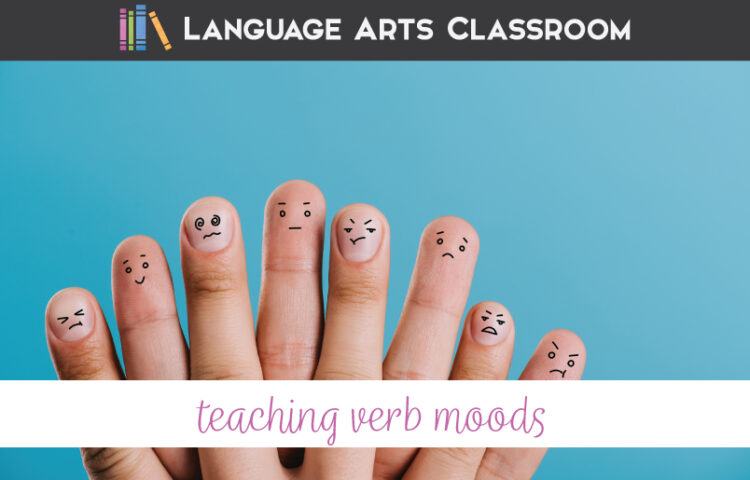Teaching verb moods requires a few talking points.
Verbs have lots of components—something I always share with students. Tenses, voice, action and linking. Helping. Some language arts classes explore modal verbs and other verb forms.
And . . then writers, which are students are, need to be aware of verb moods. Lots of subcategories branch from one part of speech.
So when I discuss any piece of verbs with my young writers, I begin by stressing that I know we spend lots of time with them. Verbs can empower sentences, and students should have the tools for using them well and for understanding their different features. My approach with verb moods lessons is similar to my other grammar lessons: I want classes to understand their language so they can be better writers and speakers.
Overall, I don’t spend tons of time on teaching the moods of verbs becaus the concepts click with students. My discussion points and activities are below.
Basic Definitions of Verb Moods
I frontload information with teaching verb moods. The definitions actually relate to their corresponding terms, so I emphasize that:
Conditional Mood: shows a “condition” —if one action happens, another action could happen.
Imperative Mood: indicates a state of demand.
Interrogative Mood: asks a question.
Indicative Mood: shows a fact.
Subjunctive Mood: shows a hypothetical state, or a condition that is not reality.
We often make five anchor charts with the definitions and examples. As we discuss literature and writing, we pull strong examples and add those to the posters. If students struggle to understand the definitions or to remember the terms, I reinforce the practice with verb mood worksheets. Sometimes, the anchor charts and sample sentences are sufficient in teaching verb moods. When classes need more practice, we use worksheets or another activity.
Activities for Verb Moods: the indicative, imperative. . .
Like I mentioned, my verb mood lessons can be short. Some classes simply latch onto the definitions, can write different moods, and quickly fix errors. Maybe you created anchor charts with the definitions and added examples as you read. You might find examples casually in literature lessons, and everyone will respond well to discussions.
Other times, you’ll need a variety of verb mood activities. When students struggle to understand the concept, consider doing a few activities:
- Give an open book/note quiz. Students might struggle to memorize all the different verb moods, and honestly, when most writers use them in their lives, they will be able to consult the definitions. When I give a quiz over verb moods, I often let students have the definitions. And? Oftentimes, students understand the concepts more than I suspected.
- Write in a variety of ways. Ask students to implement verb moods across numerous writing tasks. Doing this allows for natural practice, and connects grammar to writing.
- Take your time. You might have scheduled the study of verb moods for a week. Don’t be afraid to stretch the practice longer. If students think you are frustrated, they often become frustrated too. Try a new approach or give the lessons a few days off. Revisit verb moods when a natural opening occurs.
As you work with students, you’ll realize where you can implement verb mood practice. A great way to plan activities is to look at what your class enjoys outside of English language—graphic organizers? coloring? sort? And plan from there.
Tricks for Teaching Verb Moods: tricky English grammar
Most students do well with using verb moods especially after I cover the definitions. However, I often find myself teaching the subjunctive mood. Luckily, you can have some fun while teaching the subjunctive.
First, you should be able to find an example to illustrate how writers use the subjunctive mood in a dystopian book. For instance, here is a quote from The Hunger Games:
It’s to the Capitol’s advantage to have us divided among ourselves,’ he might say if there were no ears to hear but mine.
But—there are ears to hear, so this condition is not a reality. Dystopian literature often has examples of characters wanting something that is not reality. I pull from literature that students enjoy to highlight the subjunctive mood.
Second, students love to write in the subjunctive. Create some (fun) sentences together. If I were a flying elephant, I would give humans rides.
Silliness often helps students remember grammatical concepts. Write some ridiculous sentences together to practice.
Errors in Verb Moods: solving
Students can confuse verb moods or use them incorrectly, often with narrative or creative writing. As writing standards advance, writers have new goals and might let this aspect slip.
If one of the above methods does not fix errors in verb moods, I provide targeted practice. Sometimes students simply can’t identify their errors until they recognize the errors in other formats—an example that is not their own. Luckily (in my experience) students can spot errors in verb moods once they know what to identify. Fixing these errors takes a gentle reminder.
Finally, I will pull errors from student writing (copy and paste them, anonymously) into a presentation and correct them with students. Working through the errors and modeling corrections always helps students.
Grammar Powerpoint, worksheet: direct messaging
Some classes, especially when they study for standardized tests, become tricked up by all the labels of indicative verbs, imperative verbs, and all vocabulary that test prep encompasses. Test prep books are overwhelming with all the specific vocabulary and examples.
Share a presentation with definitions and sample sentences. Work through notes together, take a gallery walk with task cards, or run through a few worksheets.
When my older classes struggle with the concepts (often in conjunction with test prep), I take them back to the basics. Because. . . they do understand these concepts. They are probably just overwhelmed with test prep.
Those are my fast and quick tips for teaching verb moods. Do you have any examples or tips that would help other teachers?
Need more grammar ideas? Search on this website for other grammar teaching tips.







